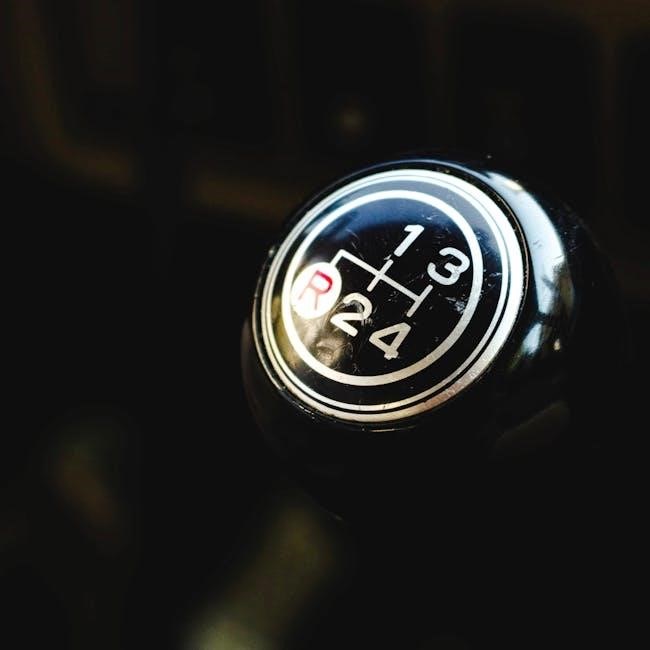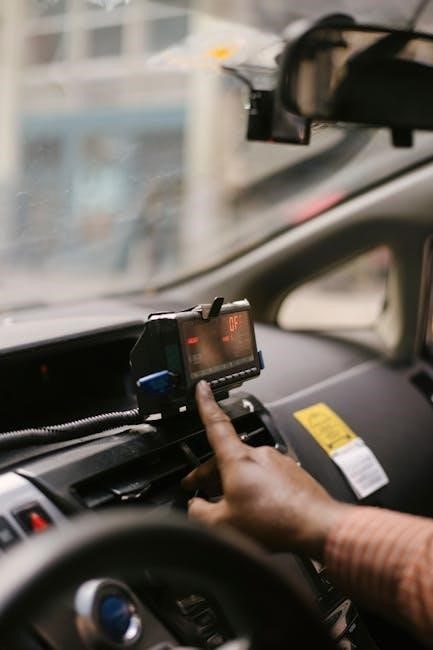Understanding multimeter ranging is crucial for accurate measurements․ Auto-ranging offers convenience and speed by automatically selecting the best range, while manual ranging provides precise control for specific tasks․
Overview of Multimeters
A multimeter is a versatile tool for measuring electrical properties like voltage, current, resistance, and continuity․ Digital multimeters (DMMs) are modern alternatives to analog designs, offering higher accuracy and ease of use․ Auto-ranging multimeters automatically select the appropriate measurement range, while manual-ranging models require users to set the range․ Both types serve specific purposes, with auto-ranging being more convenient and manual-ranging offering precise control․ Safety ratings and compliance are critical for professional use, especially with high-voltage systems․ Multimeters are essential for technicians, engineers, and DIY enthusiasts, providing reliable data for troubleshooting and analysis․
Importance of Ranging in Measurements
Ranging is critical for ensuring accurate and reliable measurements․ It allows the multimeter to adjust its sensitivity to the measured value, providing precise readings․ Proper ranging prevents errors caused by selecting the wrong scale, which can lead to inaccurate results or damage to the device․ It also enhances safety by matching the measurement range to the expected value, reducing the risk of overvoltage or overcurrent․ Accurate ranging ensures that measurements are within the multimeter’s capabilities, delivering trustworthy data for diagnostics and analysis․ This practice is essential for both auto and manual-ranging multimeters․

Understanding Auto Ranging Multimeters
Auto ranging multimeters automatically adjust to the optimal measurement range, eliminating manual selection․ This enhances efficiency and accuracy, especially in dynamic testing environments․
Definition and Functionality
An auto ranging multimeter is a digital device that automatically selects the optimal measurement range based on the input signal․ This eliminates the need for manual range selection, streamlining the process․ The multimeter uses internal sensors and algorithms to detect the signal’s magnitude and adjust accordingly․ This functionality ensures accurate readings without manual intervention, making it ideal for users who prioritize speed and convenience․ The device handles various measurement types, such as voltage, current, and resistance, with minimal user input required․ This automation enhances efficiency and reduces errors associated with manual range adjustments․
Advantages of Auto Ranging
Auto ranging multimeters offer significant advantages, primarily in terms of speed and convenience․ They eliminate the need to manually select ranges, saving time and reducing the risk of incorrect settings․ This feature is particularly beneficial for novice users, as it minimizes errors and ensures accurate measurements․ Additionally, auto ranging simplifies complex tasks by automatically adapting to varying signal levels․ It also reduces the likelihood of damage from overvoltage, as the device adjusts its range dynamically․ Overall, auto ranging enhances efficiency and usability, making it ideal for quick, precise measurements across diverse applications․
Limitations of Auto Ranging
Auto ranging multimeters have some drawbacks․ They can be slower in certain situations, as the device may take additional time to determine the correct range․ This delay can be frustrating when measuring unstable or fluctuating signals․ Additionally, auto ranging may struggle with very small measurements, potentially leading to inaccuracies․ In noisy environments, the automatic range selection might not function reliably․ Furthermore, some users find auto ranging less intuitive for complex measurements requiring multiple range adjustments․ While convenient, auto ranging may lack the precision and control offered by manual ranging in specific scenarios․

Understanding Manual Ranging Multimeters
Manual ranging multimeters require users to set the measurement range before taking readings, offering precise control over sensitivity and accuracy for specific tasks․
A manual ranging multimeter requires the user to select the appropriate measurement range before taking readings․ This is done using a dial or buttons to choose from predefined voltage, current, or resistance ranges․ The device does not automatically adjust, so the user must estimate the expected value to select the correct range․ This functionality provides precise control over measurements, reducing potential inaccuracies caused by auto-adjusting․ Manual ranging is ideal for users who understand the approximate value of the measurement, allowing for more accurate and reliable results in specific scenarios․
Advantages of Manual Ranging
Manual ranging offers precise control over measurements, enabling users to select the exact range for their needs․ This reduces errors caused by auto-ranging guesswork․ It provides better accuracy for known or stable signals, as the user can optimize the scale for the expected value․ Manual ranging also minimizes measurement noise and ensures consistent results in controlled environments․ Additionally, it often costs less than auto-ranging multimeters, making it a practical choice for applications where manual adjustments are manageable and precise measurements are critical․
Limitations of Manual Ranging
Manual ranging requires users to manually select the appropriate range, which can lead to errors if the wrong range is chosen․ It demands prior knowledge of the expected measurement value, making it less convenient for unknown or variable signals․ This method is time-consuming, as switching ranges frequently can delay tasks․ Additionally, manual ranging multimeters often lack advanced features compared to auto-ranging models․ They may also struggle with high-voltage or unstable systems, where precise range selection is critical to avoid damage or inaccurate readings․
Auto Ranging vs․ Manual Ranging: Key Differences
Auto ranging offers faster, more convenient measurements, while manual ranging provides greater accuracy and control․ Each method suits different user preferences and application needs․
Measurement Speed
Auto ranging multimeters excel in speed, automatically adjusting to the optimal range, which saves time during quick measurements․ Manual ranging, however, requires users to set the range themselves, slowing down the process․ While auto ranging is faster for general use, manual ranging offers precision for specific tasks․ The trade-off lies in convenience versus control, making each method suitable for different scenarios․ Speed differences are significant, especially in high-volume testing, where auto ranging is more efficient․
Accuracy and Precision
Auto ranging multimeters often provide consistent accuracy due to their ability to automatically select the best range for measurements․ Manual ranging, however, allows for greater precision when the user knows the expected value range, reducing potential errors․ While auto ranging is convenient, manual adjustments can offer better accuracy in specific, controlled environments․ The choice depends on the user’s need for precision versus the speed of measurement․ Both methods are reliable but cater to different measurement scenarios and user preferences․
Ease of Use
Auto ranging multimeters are generally easier to use, as they eliminate the need to manually select ranges, saving time and reducing the learning curve․ This makes them ideal for beginners or quick measurements․ Manual ranging, while offering more control, requires users to understand the expected measurement range, which can be time-consuming and complex․ Auto ranging simplifies the process, while manual ranging appeals to experienced users who value precision and customization․ The choice hinges on the user’s familiarity with measurements and the need for convenience versus control․
Versatility in Measurements
Auto ranging multimeters excel in versatility, as they automatically adjust to various measurement types and ranges, making them suitable for diverse applications․ They seamlessly transition between voltage, current, resistance, and other functions without manual intervention․ Manual ranging multimeters, while less versatile in terms of automatic adjustments, still offer flexibility in specific scenarios where precise range selection is critical․ Auto ranging models are preferred for general-purpose use due to their adaptability, while manual models cater to specialized tasks requiring exact settings․

When to Use Each Type
Auto ranging multimeters are ideal for quick, general measurements, while manual ranging suits precise, specific scenarios․ Choose based on speed, accuracy, and complexity needs․
Auto Ranging in General Use
Auto ranging multimeters are best suited for general-purpose measurements where speed and convenience are prioritized․ They automatically adjust to the optimal scale, making them ideal for quick diagnostics, fieldwork, and everyday tasks․ These devices excel in situations where multiple measurements of varying ranges are required, eliminating the need for manual adjustments․ Their versatility and ease of use make them perfect for technicians, hobbyists, and professionals seeking efficient, hassle-free operation without compromising accuracy․ They are also beneficial in environments where time is a critical factor, ensuring rapid and reliable results․
Manual Ranging in Specific Scenarios
Manual ranging multimeters are often preferred in specialized scenarios requiring precise control․ They are ideal for measurements where signal stability and accuracy are critical, such as in industrial settings or bench testing․ By allowing users to set fixed ranges, manual ranging reduces errors caused by fluctuating signals․ This feature is particularly useful in high-precision applications or when working with sensitive equipment․ It also minimizes the risk of incorrect range selection, ensuring reliability in environments where exact measurements are non-negotiable․ This makes manual ranging a valuable tool for professionals needing absolute control over their measurements․

Safety Considerations
Safety is crucial when using multimeters․ Always use devices with proper voltage ratings, ensure insulation, and avoid high-voltage measurements without protection to prevent accidents․
Safety Ratings and Compliance
Safety ratings are critical for multimeters, ensuring compliance with international standards like IEC 61010 and UL 61010B; Auto-ranging and manual multimeters must meet these standards to protect users from electrical hazards․ Compliance ensures devices can withstand voltage spikes and currents safely․ Look for CAT ratings (e․g․, CAT III or CAT IV) for voltage levels and environments․ Non-compliant devices pose serious risks․ Always verify certifications before purchase to ensure reliability and safety in various applications․
Handling High-Voltage Systems
Handling high-voltage systems with a multimeter requires extreme caution․ Always ensure the device is rated for the voltage being measured, as exceeding its capacity can cause damage or safety hazards․ Use appropriate probes and avoid direct contact with live circuits․ For high-voltage applications, consider multimeters with higher CAT ratings, such as CAT III or CAT IV, which are designed for greater electrical stress․ Ensure the multimeter is set to the correct range, whether auto or manual, to avoid overload․ Follow proper lockout/tagout procedures and consult safety guidelines before measuring high-voltage systems․

Choosing the Right Multimeter
Selecting the right multimeter depends on your expertise level and measurement needs․ Auto ranging suits general use, while manual ranging is better for precise, specialized tasks․
Factors Influencing the Decision
When choosing between auto and manual ranging, consider your measurement needs, expertise level, and budget․ Auto ranging is ideal for quick, general measurements, while manual ranging offers precision for specific tasks․ Accuracy requirements, frequency of use, and the type of electrical systems you work with also play a role․ Additionally, consider the device’s durability, safety features, and brand reputation․ Your workflow and preference for simplicity versus control will ultimately guide your decision․ Balancing these factors ensures you select the most suitable multimeter for your applications․
Budget Considerations
Auto ranging multimeters are generally more expensive than manual models due to their advanced features․ Manual multimeters are often more budget-friendly, appealing to hobbyists or professionals prioritizing cost․ Auto ranging models, while pricier, offer convenience and speed, valuable for frequent use․ Mid-range options may balance affordability with essential features․ Consider your specific needs and budget to decide which type suits you best, whether for occasional use or professional applications․

Popular Auto Ranging Models
Fluke 87V is a top choice for its accuracy and durability․ Keysight and Amprobe offer reliable models․ These multimeters are popular among professionals and DIYers․
Fluke Multimeters
Fluke multimeters are the gold standard in auto ranging, offering exceptional accuracy and durability․ The Fluke 87V is a top choice for professionals, featuring True-RMS technology for precise AC voltage measurements․ Known for their robust build quality, Fluke multimeters are ideal for harsh environments․ They often include advanced features like data logging and wireless connectivity․ With a user-friendly interface and reliable performance, Fluke multimeters are favored by technicians and engineers․ Their safety ratings and compliance with international standards make them a top choice for industrial and field applications․
Other Notable Brands
Besides Fluke, other reputable brands like Agilent, Keysight, and Tektronix offer high-quality auto ranging multimeters․ Agilent’s U1253A series is known for its precision and durability, while Keysight’s True Volt models provide advanced measurement capabilities․ Tektronix’s DMM4050 is another excellent choice, offering a balance between performance and affordability․ These brands cater to both professionals and hobbyists, ensuring versatility and reliability․ Their products often feature high accuracy, user-friendly interfaces, and robust designs, making them suitable for various industrial and field applications․ They also meet rigorous safety and performance standards, ensuring trustworthiness and longevity․

Popular Manual Ranging Models
Manual ranging multimeters like the Uni-T UT33 series and Mastech MS8268 are favored for their accuracy and durability․ These models are ideal for precise, hands-on measurements․
Professional-Grade Options
Professional-grade manual ranging multimeters, such as the Fluke 87V and Amprobe PM-339, are highly regarded for their precision and durability․ These models often feature advanced measurement capabilities, including high-accuracy voltage and current readings, making them ideal for industrial and laboratory settings․ The Keysight U1273A is another top choice, offering robust construction and reliability for demanding environments․ These multimeters are designed to withstand heavy use and provide consistent performance, making them a worthwhile investment for professionals requiring exacting measurements and long-term reliability․
Budget-Friendly Choices
For those seeking affordable manual ranging multimeters without compromising on quality, options like the UNI-T UT33A and Mastech MS8268 are excellent choices․ These models offer manual range selection, ensuring accuracy for basic measurements․ They are durable, with features like overload protection and clear LCD displays․ While they lack advanced functionalities, they provide reliable performance for hobbyists and DIY projects․ Budget-friendly manual ranging multimeters are ideal for users needing precise control over measurements without the need for high-end features, making them a cost-effective solution for everyday tasks and small-scale applications․

User Reviews and Feedback
Users often compare auto and manual multimeters, with preferences split based on ease of use and required precision․ Auto ranging is favored for speed, while manual offers better control․
Auto Ranging Preferences
Many users prefer auto ranging for its convenience and speed, as it eliminates the need to manually select ranges․ Hobbyists and professionals alike appreciate the time-saving benefit, especially in high-volume testing environments; Auto ranging is particularly favored for its ease of use, making it ideal for newcomers or those who want to focus on the task at hand without worrying about range settings․ Reviews highlight its ability to simplify complex measurements and reduce errors, making it a popular choice for general-purpose use across various industries․
Manual Ranging Preferences
Manual ranging is often preferred by professionals who value precision and control over their measurements․ Experienced technicians and engineers appreciate the ability to set exact ranges, ensuring accuracy in specialized tasks․ This feature is particularly useful in environments where precise measurements are critical․ Additionally, manual ranging multimeters are often more cost-effective, making them a favorite among budget-conscious users․ For those who prioritize control and reliability in sensitive applications, manual ranging remains the preferred choice, offering a level of customization that auto ranging cannot match․
Expert Opinions
Experts recommend auto ranging for general use due to its convenience and speed, while manual ranging is favored for precision in specialized applications․
Recommendations for Different Users
Experts suggest auto ranging multimeters for hobbyists and DIYers due to their ease of use and time-saving capabilities․ Professionals, however, often prefer manual ranging for precise measurements in critical applications․ For budget-conscious users, manual ranging multimeters are cost-effective and reliable․ Auto ranging is ideal for those prioritizing convenience, while manual suits those needing accuracy․ Both types cater to different needs, making the choice dependent on the user’s specific requirements and expertise level․ Balancing these factors ensures optimal performance for various scenarios․

Maintenance and Calibration
Regular calibration ensures accuracy, following manufacturer guidelines is crucial․ Cleaning probes, proper storage, and correct battery use extend lifespan and maintain functionality effectively․
Calibration Needs
Calibration is essential for maintaining accuracy in both auto and manual ranging multimeters․ Regular checks ensure measurements remain reliable over time․ Calibration frequency depends on usage and environmental conditions, with yearly checks recommended for most users․ Auto-ranging multimeters may require less frequent calibration due to their internal adjustments, while manual models need precise setup to maintain accuracy․ Always follow the manufacturer’s guidelines to avoid measurement errors․ Improper calibration can lead to inaccurate readings, potentially causing safety hazards or equipment damage․ Proper techniques and tools are vital to ensure reliable performance․
Regular Maintenance Tips
Regular maintenance is crucial for ensuring the longevity and accuracy of both auto-ranging and manual ranging multimeters․ Start by cleaning the probes with alcohol wipes or fine sandpaper to remove dirt and corrosion, which can interfere with conductivity․ For battery-powered models, remove the batteries during long-term storage to prevent leakage and damage․ Store the multimeter in a dry, cool place away from direct sunlight and moisture․ Avoid touching internal components to prevent static discharge․ Check for firmware updates to ensure optimal performance․ Finally, always consult the user manual for model-specific maintenance recommendations to keep your multimeter functioning accurately and reliably over time․
Final Thoughts
The debate between auto ranging and manual ranging multimeters ultimately depends on user preferences and specific tasks․ Auto ranging offers unmatched convenience and speed, ideal for fieldwork and quick measurements, while manual ranging provides precise control, essential for specialized applications․ Beginners may prefer auto-ranging for its simplicity, whereas experienced professionals often value the accuracy of manual adjustments․ Choosing the right multimeter involves balancing ease of use, measurement requirements, and personal expertise to ensure optimal performance in varying scenarios․
Future Trends in Multimeters
Future multimeters are expected to integrate advanced digital features, such as AI-driven auto-ranging, for enhanced accuracy and speed․ Manual ranging may evolve with smarter interfaces, combining precision with ease of use․ Hybrid models blending auto and manual functionality could become prevalent, catering to diverse needs․ Wireless connectivity and data-sharing capabilities will likely improve, enabling seamless integration with smartphones and computers․ Energy-efficient designs and extended battery life are also anticipated, making portable multimeters more reliable for fieldwork․ These innovations aim to deliver versatile, user-friendly tools for professionals and hobbyists alike․
References and Further Reading
For a deeper understanding of multimeter functionality, explore resources from reputable manufacturers like Fluke and Keysight․ Websites such as Fluke and Keysight offer detailed guides on auto and manual ranging․ Additionally, forums like EEVblog provide hands-on reviews and comparisons․ Academic publications on electrical engineering, such as those found on IEEE Xplore, also discuss measurement techniques․ For practical insights, textbooks like The Art of Electronics by Paul Horowitz and Winfield Hill are highly recommended․

